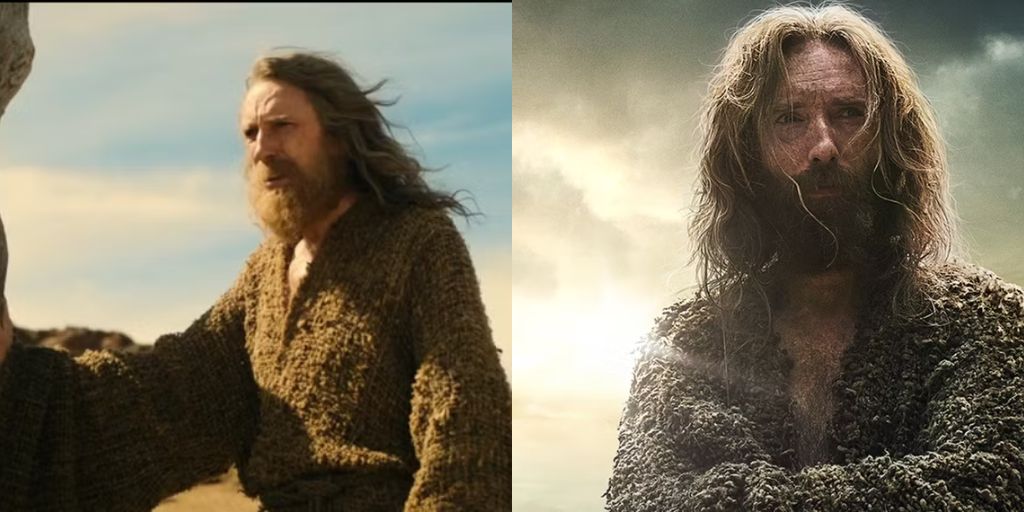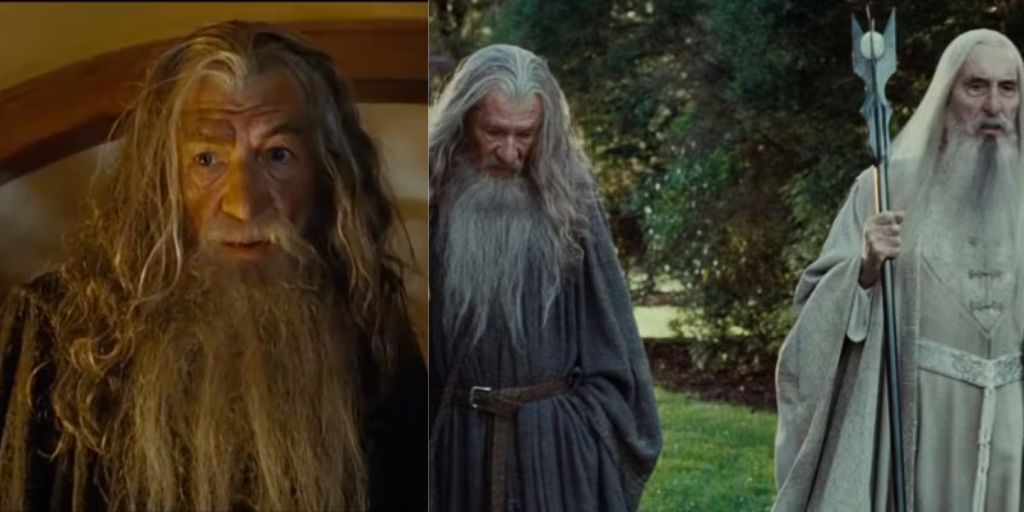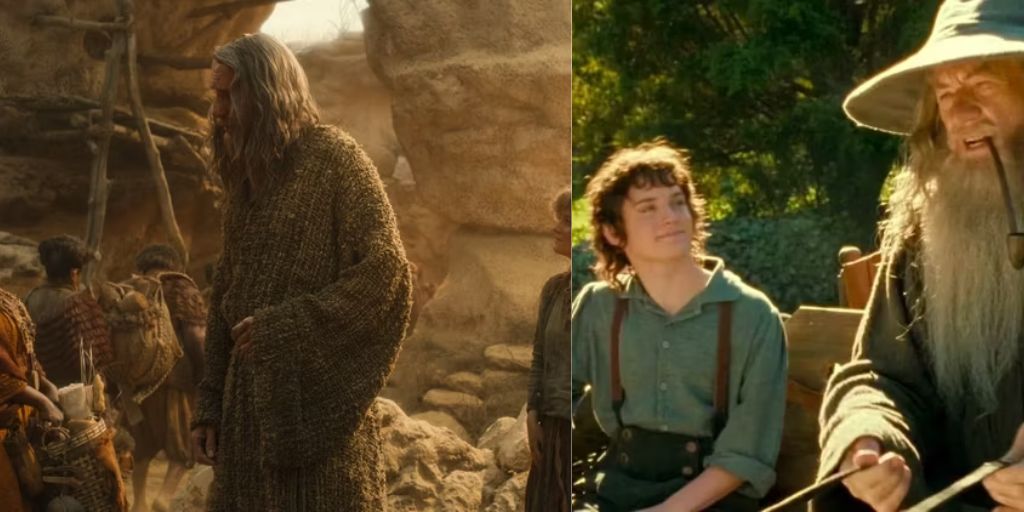Season 2 of The Lord of the Rings: The Rings of Power is finished, but it is always special to return to Middle-earth. Even with all the fighting and destruction, the last episode, titled “Shadow and Flame,” leaves us with a hopeful feeling. This episode hints at exciting places that will appear in Season 3.
It also answers a big question that has been around since the beginning of the series: who is the Stranger, played by Daniel Weyman? After two full seasons of wondering and guessing, we finally learn the answer. While it may not be a big surprise, it is nice to finally settle this mystery.
Season 2 Confirms That There Is Only One Character the Stranger Could Have Been
Viewers have argued and speculated since Season 1 of The Rings of Power about the true identity of the Stranger. Finally, Season 2 gives us the answer. In “Shadow and Flame,” he discovers that his true name is Gandalf. This means he has been everyone’s favorite wizard all along.
This moment is the peak of his journey in the second season. It shows his growth as he saves his friends and confronts his enemy, the Dark Wizard played by Ciarán Hinds. Tom Bombadil, played by Rory Kinnear, teaches the Stranger that his name and staff will come to him naturally once he understands his mission in Middle-earth.
Throughout Season 2, the show provides many hints for viewers to follow. These clues make it possible to think that the Stranger is Gandalf from very early on. For instance, he rejects every name his friend Nori, played by Markella Kavenagh, suggests in the first episode, “Elven Kings Under the Sky.”
In Episode 2, “Where the Stars Are Strange,” Nori and Poppy, played by Megan Richards, discuss the Stranger’s powers and talk about getting him “a gand” to help him use his abilities. Later, in Episode 6, titled “Where Is He?,” the Stranger speaks with Tom Bombadil about “serving the Secret Fire.”
Tom gives him the famous line: “many that die deserve life, some that live deserve death,” which Gandalf, played by Ian McKellen, shares with Frodo in The Lord of the Rings: The Fellowship of the Ring. Finally, in “Shadow and Flame,” the Stoors refer to him as “Grand-Elf,” which leads him to the conclusion that he will be called Gandalf.
These hints are enough for anyone to figure out the connection. However, there is a simpler reason for the Stranger to be Gandalf: he is such a beloved character that he cannot be left out of The Lord of the Rings story.
Some timeline issues might suggest he should not be present during the time of The Rings of Power, but most viewers likely do not worry about that. Gandalf connects the series to the movies and novels, making it easier for the audience to feel connected to the story.

Additionally, Gandalf’s popularity makes him an important character to attract more viewers. If all those hints were just to lead to him being someone else, many would feel frustrated, especially casual viewers who do not care about J.R.R. Tolkien’s original writings, as long as the story makes sense.
Gandalf Is One of the Istar, but What Does That Mean for His Story?
Season 2 gives us many hints about the Stranger being Gandalf. However, there were also clues in Season 1. In Season 1, his story is about discovering himself and relearning the basics of his powers. After he falls from the sky on a giant meteor, some fans thought he could be Sauron.
This theory even fooled the Dark Wizard, who sent a group of minions called the Mystics to find “Sauron” and take him to Rhûn. When they realize they made a mistake, they immediately recognize the Stranger as an Istar.
The Dark Wizard is also an Istar, meaning they belong to the same group of magical beings as the Stranger. The Istari are Maiar, which are angelic beings that assist the Valar in managing and shaping Middle-earth. Sauron and the Balrog of Khazad-dûm are also Maiar, showing that there can be both good and evil spirits among them.
In Tolkien’s legend, the Istari are five Maiar sent by the Valar to Middle-earth during the Third Age. Their mission is to help rekindle the flame of resistance against Sauron’s growing power. In the books, Gandalf the Grey is the Istar whose task is to travel around Middle-earth, warning the Free Peoples about Sauron and inspiring them to resist the Dark Lord.
The other four Istari have different but complementary missions. Saruman the White is the leader of the Istari. He embodies the struggle against darkness and keeps track of the other wizards’ missions.
Radagast the Brown focuses on protecting nature from darkness, befriending animals and plants throughout Middle-earth. Lastly, Alatar and Pallando are the Blue Wizards. Their mission is to weaken Sauron’s influence in the East and South, especially in Rhûn and Khand.
At the end of Season 1, when viewers learn that the Stranger is an Istari, some connected the dots and concluded he must be Gandalf. Others thought this conclusion was too obvious, so they speculated that he might be another Istari.
His brown robes led some to believe he could be Radagast, while others thought he might be Saruman since the White Wizard travels into Rhûn earlier in his journey. Some viewers believed he could be one of the Blue Wizards, as they are sent to Middle-earth in the Second Age, while Gandalf and the others arrive in the Third Age.
Since they go to the East, this theory made sense. However, with so many Gandalf references scattered throughout the series, it would likely confuse viewers if he turned out to be one of the Blue Wizards.
Gandalf’s Mission in Middle-earth Remains a Mystery at This Point
In Tolkien’s books, Gandalf arrives in Middle-earth under very different circumstances compared to The Rings of Power. For instance, it is during the Third Age, when the threat of Sauron seems to be gone. In contrast, in the series, the Dark Lord is actively trying to control the land during the Second Age.

These two situations create very different contexts. In the first context, Gandalf has time and freedom to do things like enjoy parties with Hobbits in the Shire. However, in the second context, he must take a more hands-on and focused approach.
As a wandering wizard, Gandalf’s role in the fight against Sauron in the Second Age remains unclear, although Tom Bombadil hints at what it might be. In Episode 4, “Eldest,” he and the Stranger discuss learning to use magic and finding purpose. Tom mentions that, although the Stranger is powerful, he is a wanderer, not a warrior.
He adds that “great deeds are left to the hands they were placed in.” He warns that Sauron and the Dark Wizard can join together into a flame that may consume all of Middle-earth. The Stranger quickly asks if his task is to stop the fire and confront Sauron. Tom responds that his mission is to face both threats.
This makes us think about the Stranger potentially going against Sauron in a grand battle. However, that cannot happen according to Tolkien’s rules. The fight against Sauron in the Second Age is carried out by Elves and Mortal Men.
These two races struggle against different aspects of the enemy. The Elves fight to preserve the Light of the Eldar, their magical powers in Middle-earth. This is why they create their three Rings of Power. Meanwhile, Men face tests of resolve and moral strength against a clever and tempting foe.
The involvement of an Istar at this stage is hard to imagine because, in theory, they have no narrative growth to gain. There is still a whole age that follows Sauron’s defeat against the Elves and Men, where the Dark Lord returns.
So if the Istari are present and Sauron is still around, it would mean they have failed in their mission. It may be that The Rings of Power chooses this path, but that is still a long way off. For now, Gandalf has more growth ahead.
Gandalf Still Has Many Names To Earn Before He Can Face Sauron
Now that The Lord of the Rings is a successful and established pop-culture franchise, it can be hard to view certain characters differently than the common audience understands them. Before The Rings of Power, we knew that Gandalf, Saruman, and Radagast were unique wizards.
However, the term “Istar” had never been mentioned on screen before. This aspect makes these characters great in Tolkien’s legend: they are known by many different names. Gandalf is just the first name that the Stranger learns about himself. It is certainly the most famous, but it is one of many—five, to be exact.
In Peter Jackson’s movie trilogy, the Hobbits and Humans call Gandalf the Grey Wizard. However, the Elves have a different name for him. They call him Mithrandir, which means “grey pilgrim.” This name reflects his clothing and his constant traveling between places.
Additionally, he has at least three other names, each showing different parts of his identity or role among various peoples. As a Maiar, he has an “official” Ainur name: Olórin. This was his name in the Undying Lands of Valinor before he came to Middle-earth, reflecting his identity in that earlier life.
Among the Dwarves, he is called Tharkûn. Although the exact meaning is not clear in the texts, it is believed to mean “man of the staff,” referring to his appearance or deeds among them. Finally, the people of the South, especially around Gondor, refer to him as Incánus, meaning “Mind Master.”
This name carries a negative connotation since he is not often welcomed there. In Gondor and Rohan, he is usually tolerated but not always warmly received, as he often appears when bad news is about to arrive. Nevertheless, having Gandalf or Incánus around is still better than the alternative.
Of course, “Gandalf” has a special meaning as well. Tolkien based this name on Norse mythology, where it means “Elf of the wand.” This is a nod to the fact that the wizard carries his staff and needs it to perform his most powerful magic. In Old Norse, “gandr” means “wand” or “staff,” while “álfr” means “elf.”
Therefore, “Gandálfr,” which became “Gandalf,” combines these elements to mean “Elf of the Wand” or “Wand-elf.” Although Gandalf is not an Elf but a Maia, this name reflects his connection to magic and wisdom, as well as his use of a staff, which is central to his identity as a wizard.
Tolkien’s method of forming names for his characters is elaborate and sometimes amusing. The Stoors calling the Stranger “Grand-Elf,” which later becomes “Gandalf,” is both funny and weird, showcasing the playful nature of Tolkien’s writing. The humor adds a unique charm to the story.
Even though Gandalf is not an Elf, as Nori points out in “Shadow and Flame,” the Stoors have never encountered an actual Elf. To them, anyone taller than them could be considered an Elf. It is also significant that Tom Bombadil does not confirm anything when the Stranger arrives at his house and claims his name is Gandalf.
This is the moral of the story: a wizard’s name, like his staff, finds him, not the other way around. Thus, if Gandalf says his name is Gandalf, then it must truly be Gandalf. He is no longer a stranger.

As Season 2 of The Lord of the Rings: The Rings of Power concludes, it leaves viewers excited for what lies ahead in Middle-earth.
The reveal of the Stranger’s identity as Gandalf brings a sense of closure while also opening up new possibilities for future storylines. With his many names yet to be earned and a mission still unfolding, Gandalf’s journey promises to be filled with growth, challenges, and, undoubtedly, more adventures.
Season 2 of The Rings of Power successfully unveils the true identity of the Stranger as Gandalf, connecting the story to the rich scheme of Tolkien’s universe. The series masterfully incorporates themes of friendship, identity, and the battle between good and evil while introducing audiences to the complexities of the Istari.
As fans look forward to Season 3, they can eagerly anticipate more thrilling adventures and deeper scheme of Gandalf’s character. The journey through Middle-earth continues, promising to deliver more enchanting stories and timeless lessons for all who dare to follow the path of the Rings.




